初中英语语法关于the的总结.doc
- 格式:doc
- 大小:24.00 KB
- 文档页数:2
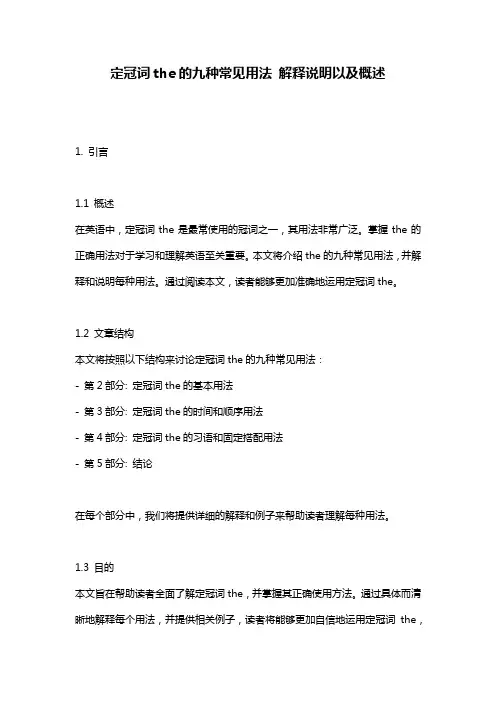
定冠词the的九种常见用法解释说明以及概述1. 引言1.1 概述在英语中,定冠词the是最常使用的冠词之一,其用法非常广泛。
掌握the的正确用法对于学习和理解英语至关重要。
本文将介绍the的九种常见用法,并解释和说明每种用法。
通过阅读本文,读者能够更加准确地运用定冠词the。
1.2 文章结构本文将按照以下结构来讨论定冠词the的九种常见用法:- 第2部分: 定冠词the的基本用法- 第3部分: 定冠词the的时间和顺序用法- 第4部分: 定冠词the的习语和固定搭配用法- 第5部分: 结论在每个部分中,我们将提供详细的解释和例子来帮助读者理解每种用法。
1.3 目的本文旨在帮助读者全面了解定冠词the,并掌握其正确使用方法。
通过具体而清晰地解释每个用法,并提供相关例子,读者将能够更加自信地运用定冠词the,从而提高英语表达能力。
此外,在文章结束时,我们还会强调定冠词the的重要性,并提示读者参考其他语法规则以获得更全面的英语知识。
通过本文的阅读,读者将掌握定冠词the的九种常见用法,并能在不同语境下正确使用。
让我们开始学习吧!2. 定冠词the的基本用法:定冠词"the"是英语中最常见的冠词之一,它有着多种用法和含义。
在这部分,我们将详细解释并概述定冠词"the"的九种常见用法。
2.1 特指特定事物或人物:定冠词"the"用于特指某个已知的、独特的事物或人物。
它使读者或听众能够明确地了解到所提及的对象是何种对象,与其他类似对象进行了区分。
例如:- I saw the dog that bit me yesterday.(我看到了昨天咬我的那只狗。
)- The Eiffel Tower is located in Paris.(埃菲尔铁塔位于巴黎。
)2.2 表示已知信息或唯一性:定冠词"the"还可以用于表达我们所讨论的内容是已知信息或者是唯一存在的。
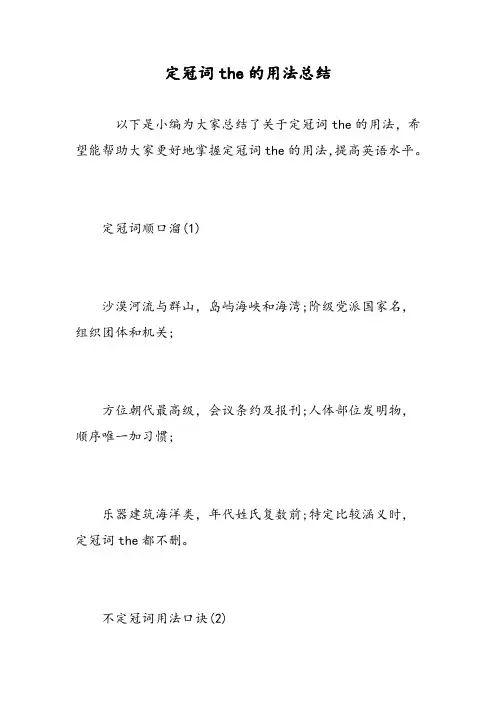
定冠词the的用法总结以下是小编为大家总结了关于定冠词the的用法,希望能帮助大家更好地掌握定冠词the的用法,提高英语水平。
定冠词顺口溜(1)沙漠河流与群山,岛屿海峡和海湾;阶级党派国家名,组织团体和机关;方位朝代最高级,会议条约及报刊;人体部位发明物,顺序唯一加习惯;乐器建筑海洋类,年代姓氏复数前;特定比较涵义时,定冠词the都不删。
不定冠词用法口诀(2)泛指首提为最多,有时表示某“一个”;物质抽象表“一场”,So加形容再“a”;可数名词为“一类”,序数词前“又一个”Quite等词常放后,固定短语须琢磨。
不用冠词顺口溜(3 )年季月周节日餐,人地抽名物质专;成对使用及洲名,学科球棋和语言Turn之表语头衔前,独立主格时无冠;可数名词代修饰,让步倒装名形前;交通工具冠词删,灵活运用是关键。
不定冠词有"a和an"两种形式。
"a"用在以辅音音素开头的词前,"an"用在以元音音素开头的词前。
判断一个词是以元音开头还是以辅音开头,是根据读音而不是根据字母。
一般情况下,an用在元音之前,而不是原音字母之前,例如hour,第一个元音是“啊”,故用an。
当字母单独出现时 A E I O R S F H L X 也要使用不定冠词"an",其次特别要注意的是 U 这个字母单独出现发的并不是原音同理UNIVERSITY USUAL也都不用不定冠词"an"。
1. 用于可数名词的单数形式前,表示"一"There is a tiger in the zoo.动物园里有一只老虎。
2. 表示"某一个"的意思A gentleman wants to see you.有一位先生要见你。
3. 表示一类人和东西A tiger can be dangerous.老虎可能有危害性。
也可用定冠词the+形容词代表一类人) The poor are still poor.4. 表示"同一"的意思They are nearly of an age.他们几乎同岁。
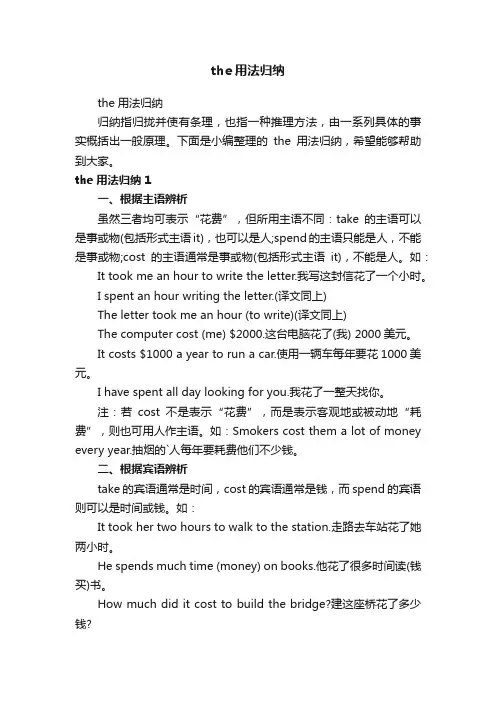
the用法归纳the用法归纳归纳指归拢并使有条理,也指一种推理方法,由一系列具体的事实概括出一般原理。
下面是小编整理的the用法归纳,希望能够帮助到大家。
the用法归纳1一、根据主语辨析虽然三者均可表示“花费”,但所用主语不同:take的主语可以是事或物(包括形式主语it),也可以是人;spend的主语只能是人,不能是事或物;cost的主语通常是事或物(包括形式主语it),不能是人。
如:It took me an hour to write the letter.我写这封信花了一个小时。
I spent an hour writing the letter.(译文同上)The letter took me an hour (to write)(译文同上)The computer cost (me) $2000.这台电脑花了(我) 2000美元。
It costs $1000 a year to run a car.使用一辆车每年要花1000美元。
I have spent all day looking for you.我花了一整天找你。
注:若cost不是表示“花费”,而是表示客观地或被动地“耗费”,则也可用人作主语。
如:Smokers cost them a lot of money every year.抽烟的`人每年要耗费他们不少钱。
二、根据宾语辨析take的宾语通常是时间,cost的宾语通常是钱,而spend的宾语则可以是时间或钱。
如:It took her two hours to walk to the station.走路去车站花了她两小时。
He spends much time (money) on books.他花了很多时间读(钱买)书。
How much did it cost to build the bridge?建这座桥花了多少钱?注:cost有时也用于时间,但通常只用于笼统时间(一般不用于具体明确的时间)。
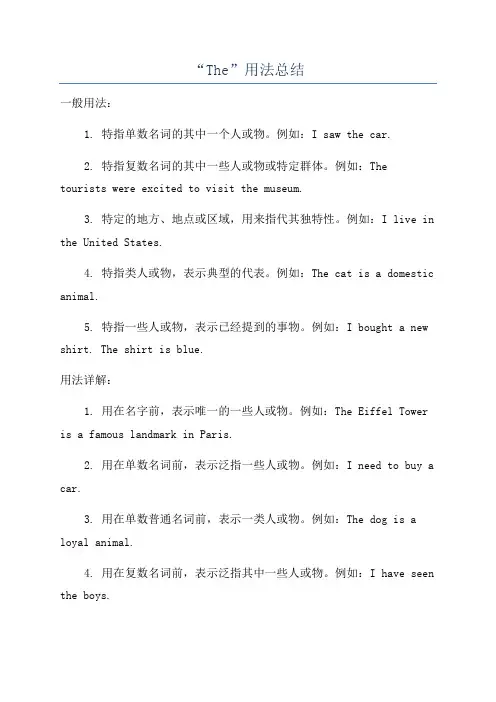
“The”用法总结一般用法:1. 特指单数名词的其中一个人或物。
例如:I saw the car.2. 特指复数名词的其中一些人或物或特定群体。
例如:Thetourists were excited to visit the museum.3. 特定的地方、地点或区域,用来指代其独特性。
例如:I live in the United States.4. 特指类人或物,表示典型的代表。
例如:The cat is a domestic animal.5. 特指一些人或物,表示已经提到的事物。
例如:I bought a new shirt. The shirt is blue.用法详解:1. 用在名字前,表示唯一的一些人或物。
例如:The Eiffel Tower is a famous landmark in Paris.2. 用在单数名词前,表示泛指一些人或物。
例如:I need to buy a car.3. 用在单数普通名词前,表示一类人或物。
例如:The dog is a loyal animal.4. 用在复数名词前,表示泛指其中一些人或物。
例如:I have seen the boys.5. 用在所有格形容词前,表示一些唯一的人或物。
例如:She isthe only girl in the class.6. 用在数量词和形容词最高级前,表示特指其中一类人或物。
例如:This is the tallest building in the city.7. 用在形容词或副词前,表示泛指其中一类人或物。
例如:Therich should help the poor.8. 用在形容词最高级前,表示特指一些人或物。
例如:He is the best player on the team.9. 用在形容词最高级前,表示泛指其中一类人或物。
例如:The fastest runner wins the race.10. 用在复数名词前,表示泛指其中一类人或物。
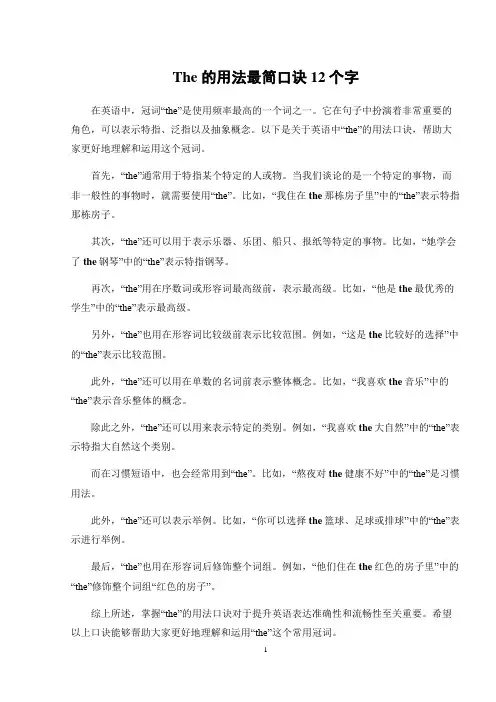
The 的用法最简口诀12个字在英语中,冠词“the”是使用频率最高的一个词之一。
它在句子中扮演着非常重要的角色,可以表示特指、泛指以及抽象概念。
以下是关于英语中“the”的用法口诀,帮助大家更好地理解和运用这个冠词。
首先,“the”通常用于特指某个特定的人或物。
当我们谈论的是一个特定的事物,而非一般性的事物时,就需要使用“the”。
比如,“我住在the那栋房子里”中的“the”表示特指那栋房子。
其次,“the”还可以用于表示乐器、乐团、船只、报纸等特定的事物。
比如,“她学会了the钢琴”中的“the”表示特指钢琴。
再次,“the”用在序数词或形容词最高级前,表示最高级。
比如,“他是the最优秀的学生”中的“the”表示最高级。
另外,“the”也用在形容词比较级前表示比较范围。
例如,“这是the比较好的选择”中的“the”表示比较范围。
此外,“the”还可以用在单数的名词前表示整体概念。
比如,“我喜欢the音乐”中的“the”表示音乐整体的概念。
除此之外,“the”还可以用来表示特定的类别。
例如,“我喜欢the大自然”中的“the”表示特指大自然这个类别。
而在习惯短语中,也会经常用到“the”。
比如,“熬夜对the健康不好”中的“the”是习惯用法。
此外,“the”还可以表示举例。
比如,“你可以选择the篮球、足球或排球”中的“the”表示进行举例。
最后,“the”也用在形容词后修饰整个词组。
例如,“他们住在the红色的房子里”中的“the”修饰整个词组“红色的房子”。
综上所述,掌握“the”的用法口诀对于提升英语表达准确性和流畅性至关重要。
希望以上口诀能够帮助大家更好地理解和运用“the”这个常用冠词。
1。
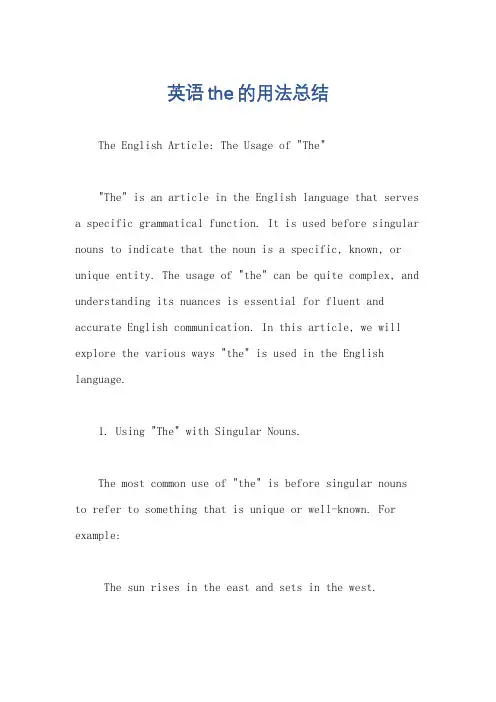
英语the的用法总结The English Article: The Usage of "The""The" is an article in the English language that serves a specific grammatical function. It is used before singular nouns to indicate that the noun is a specific, known, or unique entity. The usage of "the" can be quite complex, and understanding its nuances is essential for fluent and accurate English communication. In this article, we will explore the various ways "the" is used in the English language.1. Using "The" with Singular Nouns.The most common use of "the" is before singular nouns to refer to something that is unique or well-known. For example:The sun rises in the east and sets in the west.The Great Wall of China is a famous historical monument.In these examples, "the" is used because the sun andthe Great Wall of China are unique entities.2. Generalizations and Abstract Concepts."The" can also be used before singular nouns to referto a generalization or an abstract concept. This usage is often found in scientific, philosophical, or literary contexts. For instance:The mind is a powerful tool for learning.The theory of relativity revolutionized our understanding of physics.In these sentences, "the" is used to refer to generalizations about the mind and the theory of relativity.3. Singular Nouns Representing Categories.When a singular noun is used to represent a category or group of things, "the" is often added. This usage is common in referring to institutions, events, or types of people. For example:The government has announced a new policy.The Olympics are held every four years.The teacher is explaining the lesson to the students.In these sentences, "the" is used because the nouns "government," "Olympics," and "teacher" are representing categories or groups.4. Unique or Unusual Adjectives.When an adjective is used to describe a noun in a unique or unusual way, "the" is often added. This usage helps to emphasize the uniqueness or unusualness of the noun. For instance:The red car is parked outside.The beautiful garden is a favorite spot for locals.In these examples, "the" is used to emphasize the uniqueness or unusualness of the car's color and the garden's beauty.5. Plurals of Geographical Names and Historical Events.Although "the" is typically used with singular nouns,it can also be used with certain plural nouns, especially geographical names and historical events. For example:The United States is a diverse country.The Second World War was a devastating conflict.In these sentences, "the" is used with the plural nouns "United States" and "Second World War" to refer to them as specific, known entities.6. "The" with Superlative Adjectives.When a superlative adjective is used to describe a noun, "the" is often added. Superlative adjectives express the idea of being the most or least of something. For instance:The tallest building in the city is the Empire State Building.The fastest runner in the race was from Kenya.In these examples, "the" is used with the superlative adjectives "tallest" and "fastest" to refer to the specific building and runner being described.In conclusion, "the" is a versatile article in English that has multiple uses and applications. Understanding its various usages and when to use it correctly is essentialfor effective communication. From indicating uniqueness and known entities to emphasizing generalizations and abstractconcepts, "the" plays a crucial role in shaping the meaning and clarity of English sentences.。
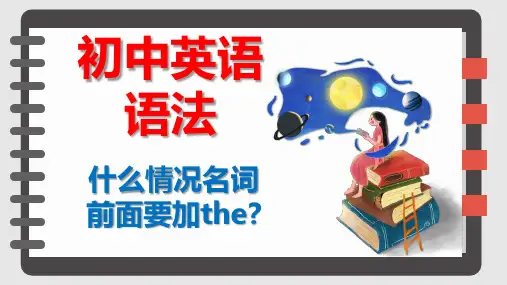
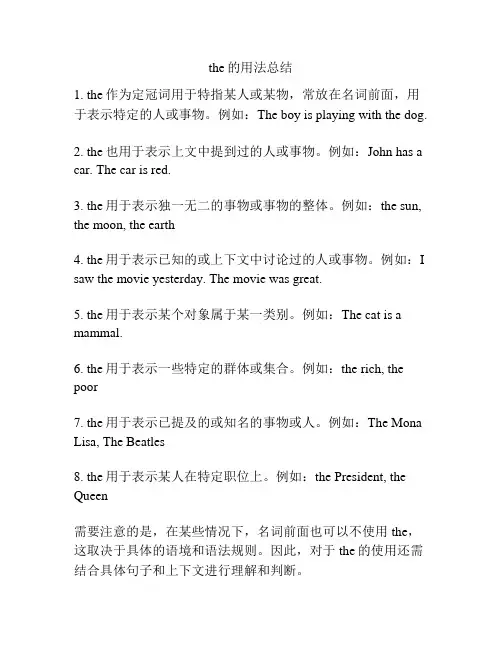
the的用法总结
1. the作为定冠词用于特指某人或某物,常放在名词前面,用于表示特定的人或事物。
例如:The boy is playing with the dog.
2. the也用于表示上文中提到过的人或事物。
例如:John has a car. The car is red.
3. the用于表示独一无二的事物或事物的整体。
例如:the sun, the moon, the earth
4. the用于表示已知的或上下文中讨论过的人或事物。
例如:I saw the movie yesterday. The movie was great.
5. the用于表示某个对象属于某一类别。
例如:The cat is a mammal.
6. the用于表示一些特定的群体或集合。
例如:the rich, the poor
7. the用于表示已提及的或知名的事物或人。
例如:The Mona Lisa, The Beatles
8. the用于表示某人在特定职位上。
例如:the President, the Queen
需要注意的是,在某些情况下,名词前面也可以不使用the,这取决于具体的语境和语法规则。
因此,对于the的使用还需结合具体句子和上下文进行理解和判断。
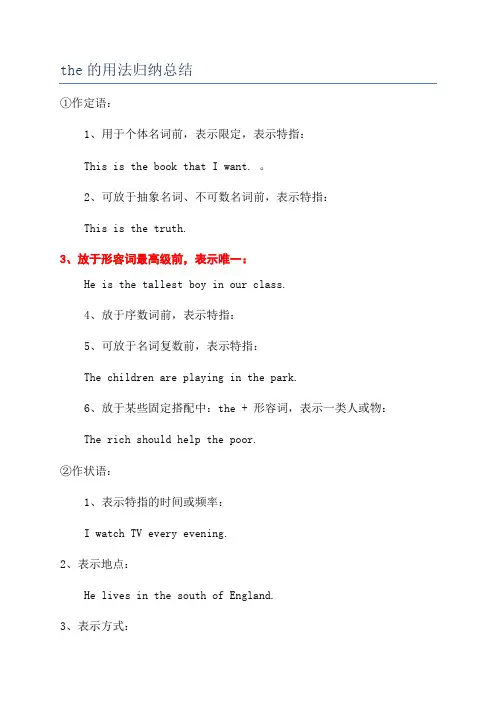
the的用法归纳总结
①作定语:
1、用于个体名词前,表示限定,表示特指:
This is the book that I want. 。
2、可放于抽象名词、不可数名词前,表示特指:
This is the truth.
3、放于形容词最高级前,表示唯一:
He is the tallest boy in our class.
4、放于序数词前,表示特指:
5、可放于名词复数前,表示特指:
The children are playing in the park.
6、放于某些固定搭配中:the + 形容词,表示一类人或物:
The rich should help the poor.
②作状语:
1、表示特指的时间或频率:
I watch TV every evening.
2、表示地点:
He lives in the south of England.
3、表示方式:
She plays the piano very well.
4、表示原因:
The students were late for class, the reason being that the bus had broken down.
5、表示比较:
The dog is bigger than the cat.
6、表示打算、目的:
She went to the library with the intention of finding some useful books.。
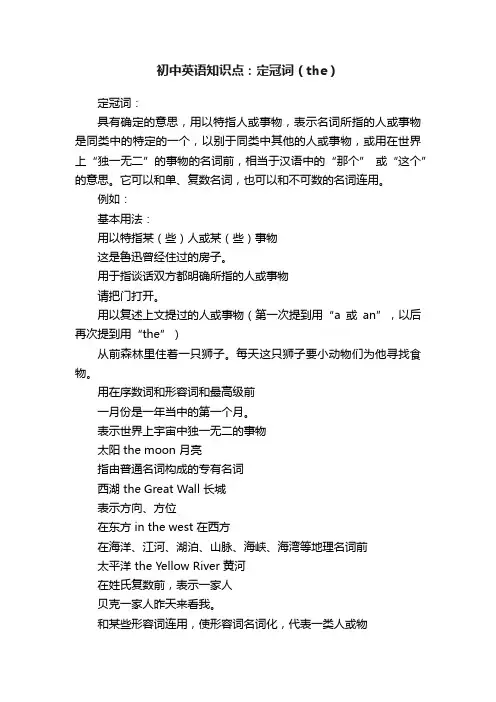
初中英语知识点:定冠词(the)定冠词:具有确定的意思,用以特指人或事物,表示名词所指的人或事物是同类中的特定的一个,以别于同类中其他的人或事物,或用在世界上“独一无二”的事物的名词前,相当于汉语中的“那个” 或“这个”的意思。
它可以和单、复数名词,也可以和不可数的名词连用。
例如:基本用法:用以特指某(些)人或某(些)事物这是鲁迅曾经住过的房子。
用于指谈话双方都明确所指的人或事物请把门打开。
用以复述上文提过的人或事物(第一次提到用“a或an”,以后再次提到用“the”)从前森林里住着一只狮子。
每天这只狮子要小动物们为他寻找食物。
用在序数词和形容词和最高级前一月份是一年当中的第一个月。
表示世界上宇宙中独一无二的事物太阳 the moon 月亮指由普通名词构成的专有名词西湖 the Great Wall 长城表示方向、方位在东方 in the west 在西方在海洋、江河、湖泊、山脉、海峡、海湾等地理名词前太平洋 the Yellow River 黄河在姓氏复数前,表示一家人贝克一家人昨天来看我。
和某些形容词连用,使形容词名词化,代表一类人或物穷人 the rich 富人表示演奏乐器时,乐器的前面要加弹钢琴拉小提琴中国乐器名词前不与冠词连用:play erhu(二胡某些固定的表达法在早上 in the afternoon 在下午在晚上 go to the cinema 去看电影关于定冠词The 的用法表示特指的人或物例:Please hand me the key on the desk. 请把桌上的钥匙递给我。
穿红色衣服的女孩是他妹妹。
那边那幢大楼是这个城里最高的。
我喜欢这部电影的音乐。
表示双方都知道的或心中明白的人或物例:Shut the door, please. 请关门。
那本书他还了吗?拿那个蓝的,它便宜些。
第二次提到某人或某物第一次提到时用不定冠词,第二次提到时要用定冠词。
例:He saw a house in the distance. Jim's parents lived in the house. 他看见远处有一所房子,吉姆的父母就住在那所房子里。
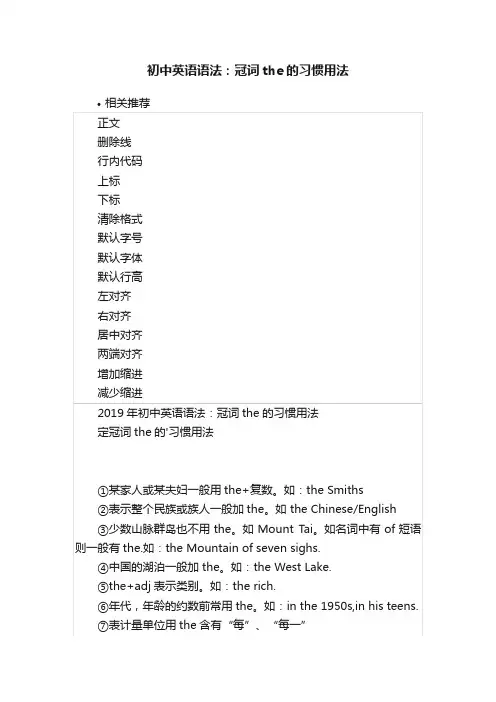
冠词the 的用法冠词 "the" 的用法一、引言在英语中,冠词是非常重要的语法元素之一。
而其中最为常用和特殊的冠词就是 "the"。
本文将探讨 "the" 的用法,涵盖单数名词、复数名词以及某些特殊情况下的用法。
二、冠词 "the" 与单数名词1. 特指特定事物或人当我们想表达某个特定的事物或人时,通常会使用 "the"。
例如:- The dog is barking loudly.(这只狗正在大声叫。
)- She is the girl I met yesterday.(她是我昨天遇到的那个女孩。
)2. 独一无二的事物或人如果我们提到的事物或人是独一无二的,则需要用 "the" 来修饰。
例如:- The moon is shining brightly tonight.(今晚月亮照耀得很亮。
)- He is the president of the company.(他是该公司的总裁。
)3. 形容词修饰后面的名词时使用当一个形容词修饰后面紧跟着的名词时,我们通常需要使用 "the"。
例如:- I love the blue sky.(我喜欢蓝天。
)- Have you seen the latest movie?(你看过最新的电影吗?)4. 某些独特的事物或群体对于一些特定的事物或群体,我们需要用 "the" 来指代。
例如:- The sun rises in the east.(太阳从东方升起。
)- I've been to the United States.(我去过美国。
)三、冠词 "the" 与复数名词1. 特定群体或类别中的人或物当我们提到某个团体、组织、类别中的人或物时,使用 "the" 加复数名词。
the的用法及区别一、The的基本用法在英语中,"the" 是一个非常常见且重要的冠词。
它有着多种用法和区别,下面将详细介绍其基本用法。
1. 指特定的人或物:当我们需要指代一个具体的人或物时,通常使用 "the"。
例如:"The dog is playing in the garden."(这只狗正在花园里玩耍。
)这里的 "the"表示我们正在谈论某一具体的狗。
2. 指特定群体或类别:当我们想指代某个特定群体或类别时,使用 "the"。
例如:"The rich should help the poor."(富人应该帮助穷人。
)这里的 "the" 引导着对富人这一具体群体做出一般性的描述。
3. 指已被提及过的事物:当我们再次提及之前已经在文章中出现过的事物时,使用 "the"。
例如:"I saw a cat in the garden. The cat was very cute."(我在花园里看到了一只猫。
那只猫非常可爱。
)第二句中的"the" 引用了前文中提到过的那只猫。
4. 表示整个种类:有时候我们使用"the" 来表示整个种族、职业或群体。
例如:"The horse is a majestic animal."(马是一种雄伟的动物。
)这里的 "the" 表示马作为整个种类。
二、The与a/an的区别除了了解 "the" 的用法外,我们还需要知道它与另一个冠词 "a/an" 的区别。
1. 特指与泛指:"the" 用于特定人或事物的指代,而"a/an" 则表示泛指。
在英文中,"the"是一个冠词,表示特定的事物或者情况。
它可以帮助读者或听者更准确地理解所描述的内容。
以下是一些关于"the"的用法的例子:用于限定名词:"The car is in the driveway." (这辆车在车道上。
)"The cat is on the table." (这只猫在桌子上。
)用于类指:"The tiger is a dangerous animal." (老虎是一种危险的动物。
)"The rose is a beautiful flower." (玫瑰是一种美丽的花。
)用于一些抽象概念的限定:"The love between a parent and a child is unconditional." (父母与孩子之间的爱是无条件的。
)"The value of a person is not determined by their appearance." (一个人的价值不是由他们的外表决定的。
)用于一些固定搭配:"The more, the better." (越多越好。
)"In the end, he succeeded." (最终,他成功了。
)用于乐器名词前:"She plays the piano every day." (她每天弹钢琴。
)用在表示方位、方向的名词前:"Let's go to the north." (让我们向北走。
)用在方位词前:"The sun rises in the east and sets in the west." (太阳从东方升起,在西方落下。
)用在序数词前:"The first day of the week is Sunday." (一周的第一天是星期天。
定冠词the的用法:定冠词the与指示代词this ,that同源,有“那(这)个”的意思,但较弱,可以和一个名词连用,来表示某个或某些特定的人或东西.(1)特指双方都明白的人或物Take the medicine.把药吃了.(2)上文提到过的人或事He bought a house.他买了幢房子.I've been to the house.我去过那幢房子.(3)指世界上独一无二的事物the sun ,the sky ,the moon, the earth(4)单数名词连用表示一类事物the dollar 美元the fox 狐狸或与形容词或分词连用,表示一类人the rich 富人the living 生者(5)用在序数词和形容词最高级,及形容词等前面Where do you live?你住在哪?I live on the second floor.我住在二楼.That's the very thing I've been looking for.那正是我要找的东西.(6)与复数名词连用,指整个群体They are the teachers of this school.(指全体教师)They are teachers of this school.(指部分教师)(7)表示所有,相当于物主代词,用在表示身体部位的名词前She caught me by the arm.她抓住了我的手臂.(8)用在某些有普通名词构成的国家名称,机关团体,阶级等专有名词前the People's Republic of China 中华人民共和国the United States 美国(9)用在表示乐器的名词前She plays the piano.她会弹钢琴.(10)用在姓氏的复数名词之前,表示一家人the Greens 格林一家人(或格林夫妇)(11)用在惯用语中in the day, in the morning...the day before yesterday, the next morning...in the sky...in the dark...in the end...on the whole, by the way...a与an的用法区别a用于辅音前;an用于元音前.一般说来,元音字母发元音,辅音字母发辅音,但需请注意以下3点:1.拼写以辅音字母开头读音却以元音开头的单词hour,honest,honor等单词的拼写虽然以辅音字母h开头,但其读音却以元音开头,因此,前面要用等单词的拼写虽然以辅音字母an.可熟记下面这句话:An hour ago,an honest man accepted an honorable task.(一小时前,一位诚实的人接受了一项光荣的任务.)2.拼写以元音字母开头读音却以辅音开头的单词useful,university,usual,European,united,one-eyed,one-way等单词的拼写虽然以元音字母开头,但其读音却以元音开头,因此,前面要用a等单词的拼写虽然以元音字母开头,但其读音却以元.可熟记下面这句话:In a university,a European and a one-eyed man walk along a one-way road with a usual tool.This is a usual thing.(在一所大学里,有一个欧洲人和一个独眼龙拿着有用的工具沿着一条单行道行走,这是件平常的事.)如:Five years ago her brother was ________ university student of ________ physics.(上海卷))A.a; theB.an; theC.an; /D.a; /【分析】答案选D.因为university是以辅音[j]开头的要用a,排除B和C;physics是学科名词,前面不用冠词.3.英文字母前用a还是用an的问题在26个英文字母中,a,e,i,o,f,h,l,m,n,r,s,x等12个字母的读音是以元音开头的,其余字母则是以辅音开头的.如:Please pay attention to your spelling.You have dropped ________ ”m” here.(全国卷)A.anB.theC./D.a【分析】答案选A.因为字母答案选m的发音是以元音[e]开头的,所以用an;这里的an的意义与one相当,表示“一个”.不定冠词a(an)的用法1.表示“一”这个数量概念,比one意思稍弱e.g.:The plan will be ready in a week or two.2.表示某人或某物,但不具体说明哪个,相当于anye.g.:This poem was written by a student.注:在1,2两项中,如果名词变复数,把a换成数词或不定代词some,any等即可.e.g.:The plan will be ready in three weeks.3.表示某一类人或事物e.g.:Even a child can answer this question.注:句中名词变复数时,去掉不定冠词a/an即可.4.和表示时间或度量衡的名词连用表示“每日”、“每斤”等e.g.:I take a two-mile walk twice a day.5.用于固定词组e.g.:have/take a shower have/take a bathtake a walk give a lecturea lot of a couple ofas a rule have a headachea few a little a bit6.不定冠词用于有形容词修饰的季节,日期前面The traffic accident happened on a Sunday towards the end of July.英语中哪些情况在名词前不用加冠词1)国名,人名前通常不用定冠词:England ,Mary;2)泛指的复数名词,表示一类人或事物时,可不用定冠词;They are teachers.他们是教师.3)抽象名词表示一般概念时,通常不加冠词;Failure is the mother of success.失败乃成功之母.4)物质名词表示一般概念时,通常不加冠词,当表示特定的意思时,需要加定冠词;Man cannot live without water.人离开水就无法生存.5)在季节、月份、节日、假日、日期、星期等表示时间的名词之前,不加冠词;We go to school from Monday to Friday.我们从星期一到星期五都上课.6)在称呼或表示官衔,职位的名词前不加冠词;The guards took the American to General Lee.士兵们把这个美国人送到李将军那里.7)在三餐、球类运动和娱乐运动的名称前,不加冠词如:have breakfast,play chess8)当两个或两个以上名词并用时,常省去冠词;I can't write without pen or pencil.没有钢笔和铅笔,我就写不了字.9)当by 与火车等交通工具连用,表示一种方式时,中间无冠词;by bus,by train;10)有些个体名词不用冠词;如:school,college,prison,market,hospital,bed,table,class,town,church,court 等个体名词,直接置于介词后,表示该名词的深层含义;go to hospital去医院看病go to the hospital去医院(并不是去看病,而是有其他目的)11)不用冠词的序数词;a.序数词前有物主代词b.序数词作副词He came first in the race.c.在固定词组中at (the) first,first of all,from first to last1. When Linda was a child, her mother always let her have ______ bed.A. the breakfast inB. the breakfast in theC. breakfast inD. breakfast in the2. Beyond ______ stars the astronaut saw nothing but ______ space.A. the, 不填B. 不填,theC. 不填,不填D. the, the3. Alexander Graham Bell invented ________ telephone in 1876.A. 不填B. aC. theD. one4. After watching ____ TV, she played _____ violin for an hour.A. 不填,不填B. the, theC. the, 不填D. 不填,the5. Many people are still in ____ habit of writing silly things in ____ public places.A. the, theB. 不填,不填C. the, 不填D. 不填,the6. Paper money was in ____ use in China when Marco Polo visited the country in ____ thirteenth century.A. the, 不填B. the, theC. 不填,theD. 不填,不填7. Have you seen ______ pen? I left it here this morning. Is it ____ black one?I think I saw it somewhere.A. a, theB. the, theC. the, aD. a, a8. She is _____ newcomer to ____ chemistry but she has already made some important discoveries.A. the, theB. the, 不填C. a, 不填D. a, the9. Many people agree that ___ knowledge of English is a must in ____ international trade today.A. a, 不填B. the, anC. the, theD. 不填,the10.______ usually go to church every Sunday.A. The BrownB. A BrownC. BrownsD. The Browns11. The train is running fifty miles ______.A. an hourB. one hourC. the hourD. a hourtob_id_295412. ___ earth we live on is bigger than___ moon.A. The, aB. The, theC. An, aD. An, the13. —What’s the matter with you ? —I caught ___ bad cold and had to stay in ___bed.A. a, /B. a, theC. a, aD. the, the14. —Do you know ___ lady in blue? —Yes. She is a teacher of a university.A. theB. aC. anD. /15. —Where’s ___ nearest supermarket? —It’s over there, just around the corner.A. aB. anC. theD. /16. The young man will work in ___ school as a maths teacher.A. theB. aC. anD. /17. Most of the representatives think that ______ the meeting was very successful.A. on whole ofB. on a wholeC. on the wholeD.on the whole that18. The investigators found that more should be done for ______ in India.A. those poorB. a poorC. poorD. the poor19. He grabbed me ______ and pulled me onto the bus.A. a armB. an armC. the armD. by the arm20. “How did you pay the workers?” “As a rule, they are paid ______.”A. by an yourB. by the hourC. by a hourD. by hours21. What _____ exciting football mat ch! Our team beat Tom’s team at last.A. aB. anC. theD. /22. In the United States, Father’s Day falls on _____ third Sunday in _____ June.A. the,不填B. the, aC. 不填, theD. a, 不填23. I have two dogs. ______ black one is two years old and ______ yellow one is three years old.A. A, aB. The, aC. The, theD. A. the24. ______ new bridge has been built over ______ Huangpu River.A. The, aB. A, /C. A, theD. An, an25. -What colour is ______ orange? -It’s _____ orange.A. an, anB. an, theC. an, /D. /, an答案与解析(部分)1. C2. A。
(完整版)the的用法定冠词the的用法:定冠词the与指示代词this ,that同源,有“那(这)个”的意思,但较弱,可以和一个名词连用,来表示某个或某些特定的人或东西.(1)特指双方都明白的人或物Take the medicine.把药吃了.(2)上文提到过的人或事He bought a house.他买了幢房子.I've been to the house.我去过那幢房子.(3)指世界上独一无二的事物the sun ,the sky ,the moon, the earth(4)单数名词连用表示一类事物the dollar 美元the fox 狐狸或与形容词或分词连用,表示一类人the rich 富人the living 生者(5)用在序数词和形容词最高级,及形容词等前面Where do you live?你住在哪?I live on the second floor.我住在二楼.That's the very thing I've been looking for.那正是我要找的东西.(6)与复数名词连用,指整个群体They are the teachers of this school.(指全体教师)They are teachers of this school.(指部分教师)(7)表示所有,相当于物主代词,用在表示身体部位的名词前She caught me by the arm.她抓住了我的手臂.(8)用在某些有普通名词构成的国家名称,机关团体,阶级等专有名词前the People's Republic of China 中华人民共和国the United States 美国(9)用在表示乐器的名词前She plays the piano.她会弹钢琴.(10)用在姓氏的复数名词之前,表示一家人the Greens 格林一家人(或格林夫妇)(11)用在惯用语中in the day, in the morning...the day before yesterday, the next morning...in the sky...in the dark...in the end...on the whole, by the way...a与an的用法区别a用于辅音前;an用于元音前.一般说来,元音字母发元音,辅音字母发辅音,但需请注意以下3点:1.拼写以辅音字母开头读音却以元音开头的单词hour,honest,honor等单词的拼写虽然以辅音字母h开头,但其读音却以元音开头,因此,前面要用等单词的拼写虽然以辅音字母an.可熟记下面这句话:An hour ago,an honest man accepted an honorable task.(一小时前,一位诚实的人接受了一项光荣的任务.)2.拼写以元音字母开头读音却以辅音开头的单词useful,university,usual,European,united,one-eyed,one-way 等单词的拼写虽然以元音字母开头,但其读音却以元音开头,因此,前面要用a等单词的拼写虽然以元音字母开头,但其读音却以元.可熟记下面这句话:In a university,a European and a one-eyed man walk along a one-way road with a usual tool.This is a usual thing.(在一所大学里,有一个欧洲人和一个独眼龙拿着有用的工具沿着一条单行道行走,这是件平常的事.)如:Five years ago her brother was ________ university student of ________ physics.(上海卷))A.a; theB.an; theC.an; /D.a; /【分析】答案选D.因为university是以辅音[j]开头的要用a,排除B和C;physics是学科名词,前面不用冠词.3.英文字母前用a还是用an的问题在26个英文字母中,a,e,i,o,f,h,l,m,n,r,s,x等12个字母的读音是以元音开头的,其余字母则是以辅音开头的.如:Please pay attention to your spelling.You have dropped ________ ”m” here.(全国卷)A.anB.theC./D.a【分析】答案选A.因为字母答案选m的发音是以元音[e]开头的,所以用an;这里的an的意义与one相当,表示“一个”.不定冠词a(an)的用法1.表示“一”这个数量概念,比one意思稍弱e.g.:The plan will be ready in a week or two.2.表示某人或某物,但不具体说明哪个,相当于anye.g.:This poem was written by a student.注:在1,2两项中,如果名词变复数,把a换成数词或不定代词some,any等即可.e.g.:The plan will be ready in three weeks.3.表示某一类人或事物e.g.:Even a child can answer this question.注:句中名词变复数时,去掉不定冠词a/an即可.4.和表示时间或度量衡的名词连用表示“每日”、“每斤”等e.g.:I take a two-mile walk twice a day.5.用于固定词组e.g.:have/take a shower have/take a bathtake a walk give a lecturea lot of a couple ofas a rule have a headachea few a little a bit6.不定冠词用于有形容词修饰的季节,日期前面The traffic accident happened on a Sunday towards the end of July.英语中哪些情况在名词前不用加冠词1)国名,人名前通常不用定冠词:England ,Mary;2)泛指的复数名词,表示一类人或事物时,可不用定冠词;They are teachers.他们是教师.3)抽象名词表示一般概念时,通常不加冠词;Failure is the mother of success.失败乃成功之母.4)物质名词表示一般概念时,通常不加冠词,当表示特定的意思时,需要加定冠词;Man cannot live without water.人离开水就无法生存.5)在季节、月份、节日、假日、日期、星期等表示时间的名词之前,不加冠词;We go to school from Monday to Friday.我们从星期一到星期五都上课.6)在称呼或表示官衔,职位的名词前不加冠词;The guards took the American to General Lee.士兵们把这个美国人送到李将军那里.7)在三餐、球类运动和娱乐运动的名称前,不加冠词如:have breakfast,play chess8)当两个或两个以上名词并用时,常省去冠词;I can't write without pen or pencil.没有钢笔和铅笔,我就写不了字.9)当by 与火车等交通工具连用,表示一种方式时,中间无冠词;bybus,by train;10)有些个体名词不用冠词;如:school,college,prison,market,hospital,bed,table,class,town,c hurch,court 等个体名词,直接置于介词后,表示该名词的深层含义;go to hospital去医院看病go to the hospital去医院(并不是去看病,而是有其他目的)11)不用冠词的序数词;a.序数词前有物主代词b.序数词作副词He came first in the race.c.在固定词组中at (the) first,first of all,from first to last1. When Linda was a child, her mother always let her have ______ bed.A. the breakfast inB. the breakfast in theC. breakfast inD. breakfast in the2. Beyond ______ stars the astronaut saw nothing but ______ space.A. the, 不填B. 不填,theC. 不填,不填D. the, the3. Alexander Graham Bell invented ________ telephone in 1876.A. 不填B. aC. theD. one4. After watching ____ TV, she played _____ violin for an hour.A. 不填,不填B. the, theD. 不填,the5. Many people are still in ____ habit of writing silly things in ____ public places.A. the, theB. 不填,不填C. the, 不填D. 不填,the6. Paper money was in ____ use in China when Marco Polo visited the country in ____ thirteenth century.A. the, 不填B. the, theC. 不填,theD. 不填,不填7. Have you seen ______ pen? I left it here this morning. Is it ____ black one?I think I saw it somewhere.A. a, theB. the, theC. the, aD. a, a8. She is _____ newcomer to ____ chemistry but she has already made some important discoveries.A. the, theB. the, 不填C. a, 不填D. a, the9. Many people agree that ___ knowledge of English is a must in ____ international trade today.A. a, 不填C. the, theD. 不填,the10.______ usually go to church every Sunday.A. The BrownB. A BrownC. BrownsD. The Browns11. The train is running fifty miles ______.A. an hourB. one hourC. the hourD. a hourtob_id_295412. ___ earth we live on is bigger than___ moon.A. The, aB. The, theC. An, aD. An, the13. —What’s the matter with you ? —I caught ___ bad cold and had to stay in ___bed.A. a, /B. a, theC. a, aD. the, the14. —Do you know ___ lady in blue? —Yes. She is a teacher of a university.A. theB. aC. anD. /15. —Where’s ___ nearest supermarket? —It’s over there, just around the corner.A. aB. anC. theD. /16. The young man will work in ___ school as a maths teacher.A. theB. aC. anD. /17. Most of the representatives think that ______ the meeting was very successful.A. on whole ofB. on a wholeC. on the wholeD.on the whole that18. The investigators found that more should be done for ______ in India.A. those poorB. a poorC. poorD. the poor19. He grabbed me ______ and pulled me onto the bus.A. a armB. an armC. the armD. by the arm20. “How did you pay the workers?” “As a rule, they arepaid ______.”A. by an yourB. by the hourC. by a hourD. by hours21. What _____ exciting football mat ch! Our team beat Tom’s team at last.A. aB. anC. theD. /22. In the United States, Father’s Day falls on _____ third Sunday in _____ June.A. the,不填B. the, aC. 不填, theD. a, 不填23. I have two dogs. ______ black one is two years old and ______ yellow one is three years old.A. A, aB. The, aC. The, theD. A. the24. ______ new bridge has been built over ______ Huangpu River.A. The, aB. A, /C. A, theD. An, an25. -What colour is ______ orange? -It’s _____ orange.A. an, anB. an, theC. an, /D. /, an答案与解析(部分)1. C2. A。
冠词the的使用规则前面我们说了一下冠词a、an的使用规则。
下面来看看the的用法规则,尽量说得多些:1、用在重新提到的或者谈话双方都知道的人或事物前面,如:Give me the map.(就是前篇a、an例句里的:This is a map里的a map,现在用the map大家都知道你想要哪张map了)2、用于世界上独一无二的事物或方位名词前,如:the sun 太阳the moon 月亮the east 东方3、用在单数可数名词前,表示某一类人或事物,(a、an也有这个功能)如:The tiger is a wild animal.老虎是一种野生动物。
4、用在形容词最高级和序数词及only所修饰的名词前,也用在表示序列的next,last 等前,以及在表示“同一”或“唯一”等的词前,如:Autumn is the best season in Beijing.秋天是北京最好的季节。
She is always the first to get to the office.她总是第一个来上班。
He is not the only one who has the idea in mind.不是仅有他一个人这样想。
5、用在江河、湖海、山脉、岛屿等的名词前,如:the River Seine塞纳河6、用在普通名词构成的专有名词(如:酒店名、报纸名、货币)前,如:the Great Wall 长城,the People's Daily 人民日报,The Hilton Hotel 希尔顿酒店The Times 《泰晤士报》The U.S. dollar 美元7、用在姓氏的复数形式前(表示一家人或一个家族),如:The Simpsons (著名电视剧辛普森一家),The Wangs have moved house.王家已经搬家了8、用在乐器名词前,如:play the piano 弹钢琴9、用在某些形容词(名词化,表一类人或事物,复数概念)前,如:the rich 富人10、用在表计量单位的名词前,表“每、每一”,如:It's sold by the yard.这是按码出售的。
初中英语语法关于the的总结
问题:《英语》(新标准)(衔接小学英语)初二上册M8中有地名前加the的情况,哪些地名前一定要加the,哪些不用呢?
回答:这很难一概而论,就我们平常常见的地名译法而言,我觉得:
1. 江河海峡等如果river, lake在后面,前多加the, the Changjiang River; 但如果在前面,就不加了,如Mount Tai
2. 地名、国名、街道等一般不加the,如Beihai Park, Hebei Province。
3. 如果有不确定的,要多查字典、多上网查证。
下面是一些国家相关部门下的资料/文件/令,供参考。
以人名命名的地名英译,人名的姓和名连写,人名必须位置,通名后置,不加定冠词。
这种译法多用于自然地理实全地名,但有例外。
例如:
1、张广才岭Zhangguangcai Mountain(吉林、黑龙江)
2、欧阳海水库存Ouyanghai Reservoir(湖南桂阳)
3、郑和群礁Zhenghe Reefs(湖南南沙群岛)
4、李准滩Lizhun Bank (海南南沙群岛)
如果以人名命名的非自然地理实体地名,姓和名分写,人名前置或后置按习惯用法,大致有以下三种译法:
1、人名+通名
黄继光纪念馆Huang Jiguang Memorial(四川中江县)
2、人名S+通名
中山陵墓Sun Yat-sen’ s Mausoleum(江苏南京市)
3、the+通名+of人名
昭君墓the Tomb of Wang Zhaojun(内蒙古呼和浩特市)
=========
专名是单音节的英译法
专名是单音节,通名也是单音节,这时通名应视作专名的组成部分,先音译并与专名连写,后重复意译,分写(汉字带点的字是通名,英语的画线部分是音译;括号内为该地所在省、市、地区或县,下同)例如:
1、恒山Hengshan Mountain (山西)
2、淮河the Huaihe River (河南、安徽、江苏)
3、巢湖the Chaohu Lake (安徽)
4、渤海the Bohai Sea (辽宁、山东)
5、韩江the Hanjiang River (广东)
6、礼县Lixian County (甘肃陇南地区)。